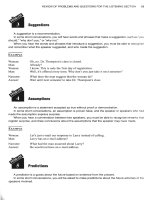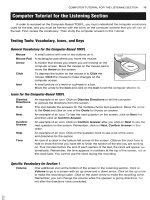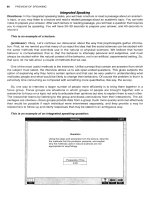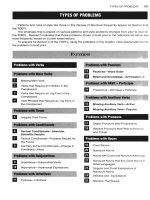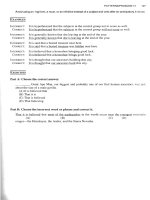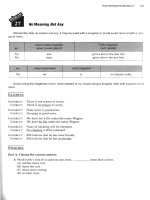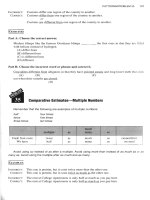Tài liệu How to prepare for the toefl part 11 pdf
Bạn đang xem bản rút gọn của tài liệu. Xem và tải ngay bản đầy đủ của tài liệu tại đây (659.17 KB, 10 trang )
96
PREVIEW
OF
SPEAKING
irrigation, it's easier to control the water and more efficient since the water is directed only on the plants.
But, in hot climates, some of the water can evaporate in the air. Still, the main problem with the sprin-
klers is the expense for installation and maintenance because there's a very complicated pipe system
and that usually involves a lot more repair and even replacement of parts, and of course, we have to
factor in the labor costs in feasibility studies for sprinklers.
Flood
Not efficient
Difficult to control-flat fields
Initial expense to build canals, ditches
Requires maintenance
Sprinkler
Complicated pipe system
Expensive to install, maintain-repair, replace
Labor cost
SCRIPT
FOR
EXAMPLE
ANSWER
Two methods of irrigation were discussed in the lecture. First, flood irrigation. It involves the release
of water into canals and drainage ditches that flow into the fields. The disadvantages of the flood
method
. .
. um . .
.
well, it isn't very efficient since more water is used in flooding than the crops actual-
ly .uh, need, and also it isn't easy to control. Another problem is the initial expense for the construction
of the canals and the connecting ditches as well as
. . .
as maintenance. And besides that, if the fields
aren't flat, the water doesn't-l mean, it isn't distributed evenly. The second method is sprinkler irriga-
tion which uses less water and provides better control, but there is some evaporation, and the pipe sys-
tem's complicated and can be expensive to install and maintain, and there's usually a lot more labor
cost because the equipment must be repaired and replaced more often than a canal system.
Checklist
(/
The talk summarizes a short lecture.
(/
There are only minor inaccuracies in the content.
I/
The talk is direct and well-organized.
(/
The sentences are logically connected to each other.
r/
Details and examples support the main idea.
d
The speaker expresses complete thoughts.
d
The meaning is easy for the listener to comprehend.
(/
A
wide range of vocabulary is used.
(/
The speaker paraphrases, using his or her own words.
(/
The speaker credits the lecturer with wording.
(/
There are only minor errors in grammar.
(/
The talk is within a range of
125-1
50
words.
COMPUTER TUTORIAL FOR THE SPEAKING SECTION
97
The Speaking Section of the Next Generation
TOEFL is being introduced as a telephone test.
It is called the TAST (TOEFL Academic Speak-
ing Test). Later, the TAST will be integrated
into the Next Generation TOEFL as the Speak-
ing Section, and it will be administered on the
Internet. For now, dial the telephone number
that you receive when you register. Then, fol-
loLv the directions that you hear. You will be told
when to prepare each answer and when to
begin speaking. It is important to speak directly
into the telephone. Speak up. If your voice
is
too soft, the rater will not be able to grade your
answers.
98
PREVIEW
OF
SPEAKING
Become familiar with the
types
of questions you will
be
asked.
If you are listening to the kinds
of questions that you expect to hear, you will be more prepared to organize your answers. That is why it
is so important to study using the review section in this book, and to practice using the model test.
Develop a sense of timing for the short speaking answers.
You will be speaking for only
45-60
seconds, and that isn't very long to develop a complete answer. When you are answering the practice
questions in this book, set a kitchen timer for
60
seconds and begin speaking. When the bell rings, stop.
Did you complete your thought, or did you have more to say? Always use the timer when you are prac-
ticing. Soon you will develop a sense of the timing for the questions, and you will know how much you
can say in a short answer.
Practice using the telephone to speak.
Call a friend to practice some of the speaking questions by
phone. Speak directly into the phone. Ask your friend to confirm that you are speaking at a good volume
to be heard clearly.
Maintain
a
positive attitude toward the experience.
It is natural to be a little anxious about speak-
ing in a second language, but it is important not to become negative and frightened. Negative thoughts
can interfere with your concentration, and you may not hear the questions correctly. Take some deep
breaths before each question, and say this in your mind,
"I
am a good speaker. I am ready to speak." If
you begin to have negative thoughts during the test, take another deep breath, and think "confidence"
as you breathe in. Focus on listening to the questions. Focus on taking notes.
Choose a quiet place to take your test.
Choose a room with a telephone where you can be alone.
Close the door. Make a sign for the door asking friends and family not to enter while you are taking your
test. Turn off pagers and cell phones. Eliminate other distracting noises. If you are disturbed while you
are taking your test, you will not hear the questions, and you will lose valuable preparation time. Gather
the materials that you need for the test. Always have an extra pencil in case you need it. Then, clear the
desk or table that you will use for taking notes. If you see only the questions and your notes, you will
focus more easily.
Do you talk to yourself? Of course you do. Maybe not aloud, but all of us have mental conversations
with ourselves. So the question is
how
do you talk to yourself?
Negative Talk Positive Talk
I can't study all of this.
My English is poor.
I won't get a good score.
If I fail, I will be so ashamed.
I am studying every day.
My English is improving.
I will do my best.
If I need a higher score, I can try again.
How would you talk to good friends to encourage and support them? Be a good friend to yourself.
When negative talk comes to mind, substitute positive talk. Encourage yourself to learn from mistakes.
REVIEW
OF
STRUCTURE
OVERVIEW OF THE STRUCTURE SECTION
101
QUICK COMPARISOH-SfRUCTURE
PAPER-BASED TOEFL,
COMPUTER-BASED TOEFL, AND NEXT GENERATION TOEFL
Paper-Based
TOEFL
Computer-Based
TOEFL
Next
Generation
TOEFL
Two types of questions
Two types of questions
There is NO
are presented in separate
are presented at random in
Structure Section.
parts. Part A has incomplete one continuous section. You
sentences, and Part
B
has
may see two incomplete
sentences with underlined
sentences, one sentence with
words and phrases. underlined words and phrases,
another incomplete sentence,
and so fgrth.
All of the questions are
multiple-choice.
All of the questions are
multiple-choice.
Everyone taking the TOEFL
The computer will select questions
answers the same questions. based on your level of proficiency.
Every question has only Every question has only one
one answer. answer.
You have twenty-five minutes to
You may control the pace by
complete the section.
choosing when to begin the
next question, but the section
is timed.
A
clock on the screen
shows the time remaining for
you to complete the section.
You answer on a paper
Answer Sheet, filling in
ovals marked
a, a, a,
and
a.
You can return to previous
questions, erase, and
change answers on your
Answer Sheet.
The score on the Structure
Section is not combined with
the score on the essay
in the Test of Written
English (TWE).
You click on the screen either
in the oval or on the underlined
word or phrase.
You cannot return to previous
questions. You can change
your answer before you click
on
Confirm Answer.
After you
click on
Confirm Answer,
you
will see the next question. You
cannot go back.
The score on the Structure Section is
combined with the score on
the essay in the Writing Section.
102
REVIEW
OF
STRUCTURE
The Structure Section of the TOEFL tests your ability to recognize standard written English as it
is
used in North America. The Structure Section is included in the Paper-Based TOEFL and the Computer-
Based TOEFL, but it is not included as a separate section in the Next Generation TOEFL.
Paper-Based TOEFL (PBT)
The directions for the Paper-Based TOEFL are reprinted with the permission of Educational Testing
Service
(ETS)
from the official
Information Bulletin
for the Supplemental Paper-Based TOEFL.
Section
2
-
Structure
and
Written
Expression
This section is designed to measure your ability to recognize language
that is appropriate for standard written English. There are two types
of questions in this section, with special directions for
each type.
Structure
Directions: These questions are incomplete sentences. Beneath each
sentence you will see four words or phrases, marked (A), (B). (C), and
(D).
Choose the one word or phrase that best completes the sentence.
Then, on your answer sheet, find the number of the question and fill in
the space that corresponds to the letter of the answer you have chosen.
Look
at
the following examples:
Example
I
Sample Answer
Geysers have often been compared to volcanoes
@
0
@
@
-
-
- - -
they both emit hot liquids from below
the Earth's surface.
(A) due to
(B)
because
(C)
in spice of
(D)
regardless of
The sentence should read. "Geysers have often been compared to
volcanoes because they both emit hot liquids from below the Earth's
surface." Therefore, you should choose answer (B).
Example
I1
Sample Answer
During the early period
of
ocean navigation,
@@Om
any need for sophisticated instmenls
and techniques.
(A)
so that hardly
(B)
where there hardly was
(C)
hardly was
(D) there was hardly
The sentence should read, "During
the
early period of ocean navigation,
there was hardly any need for sophisticated instruments and techniques."
Therefore, you should choose answer
(D).
Written
Expression
Directions: In these questions, each sentence has four underlined
words or phrases. The four underlined parts of the sentence are marked
(A),
(B), (C), and (D). Identify the one underlined word or phrase that
must be changed in order for the sentence to be correct. Then. on your
answer sheet, find the number of the question and fill in the space that
corresponds to the letter of the answer you have chosen.
Look at the following examples:
OVERVIEW
OF THE
STRUCTURE
SECTION
103
Example
I
Sample
Answer
Guppies are sometimes rainbow fish because
m
@
@ @
A
B
C
of the males' brightcolors.
D
The sentence should read, "Guppies are sometimes called rainbow fish
because of the males' bright colors." Therefore, you should choose
answer
(A).
Example
11
Sample
Answer
Serving several
term
in Congress. Shirley
@-@a
A
B
Chisholm became an important United States
politician.
C
D
The sentence should read. "Serving several terms in Congress, Shirley
Chisholm became an important United States politician.'' Therefore,
you should choose answer
(B).
Computer-Based
TOEFL
The directions for the Computer-Based
TOEFL
are reprinted with the permission of Educational
Testing Service (ETS) from the official
Information Bulletin
for the Computer-Based
TOEFL.
This section measures the ability to recognize language that is appropriate for standard written Eoglish.
There are two types of questions in this section.
In the first type of question, there are incomplete sentences. Beneath each sentence, there are four
words or phrases. You will choose the one word or phrase that best completes the sentence.
Here
is
an example.
The columbine flower,
all of the United States, can be raised from
seed in almost any garden.
0
native
0
how native
is
0
how native
is
it
0
is
native
104
REVIEW
OF
STRUCTURE
Clicking on a choice darkens
the
oval. The correct answer is indicated on the screen below.
The columbine flower. to nearly
all
of the United States, can be raised from
seed in almost any garden.
0
native
0
how native is
0
how native is it
0
is native
After you click on
Next
and
Confirm Answer,
the next question will be presented.
The second type of question has four underlined words or phrases. You will choose the one underlined
word or phrase that must be changed for the sentence to be correct.
Here
is
an example:
One of the difficult problems in understanding
sleep is determining what the functions of sleep
E.
or the sentence to be
REVIEW OF PROBLEMS
AND
QUESTIONS FOR THE STRUCTURE SECTION
105
Clicking on an underlined word or phrase will darken it. The correct answer is indicated on the screen
below.
ord or phrase that must be changed
One of the difficult problems in understanding
sleep is determining what the functions of sleep
The sentence should read: One of the most difficult problems in understanding sleep is determining
what the functions of sleep are. After you click on
Next
and
Confirm
Answer,
the next question will be
presented.
Next Generation
TOEFL
There is no Structure Section in the Next Generation TOEFL. Structure is scored on the rating scale for
bo!h the Speaking Section and the Writing Section.
This Review can be used to prepare for both the Paper-Based TOEFL and the Computer-Based
TOEFL. For the most part, the same types of problems are tested
on
both the Paper-Based TOEFL and
the Computer-Based TOEFL. All of the questions on both the Paper-Based TOEFL and the Computer-
Based TOEFL are multiple-choice. Computer-assisted questions have special directions.
Strategies
and
Symbols
for
Review
Strategjes
How will this Review of Structure help you?
It won't teach you every rule of English grammar, but it will provide you with a review of the prob-
lems in structure and written expression that are most commonly tested on the TOEFL.
Use this review to study and to check your progress. Follow three easy steps for each problem.
1.
Review the generalization.
First, read the explanation and study the word order in the chart.
Then, close your eyes, and try to see the chart in your mind.
106
REVIEW
OF
STRUCTURE
2.
Study the examples.
Focus on the examples. First, read them silently, noting the difference be-
tween the correct and incorrect sentences. Then, read the underlined parts of the correct sen-
tences aloud.
3.
Check your progress.
First, complete the exercise. Each exercise has two questions-ne simi-
lar to Part A and the other similar to Part
B
on the Structure and Written Expression section of
the TOEFL. Then, check your answers, using the Answer Key in Chapter 9 of this book.
If you are studying in an English program, use this review with your grammar book. After your teacher
presents a grammar rule in class, find it in the table of contents of this review (see pages 107-109). Refer
to the generalization, study the examples, and check your progress by completing the exercise.
When you go to your next grammar class, you will be more prepared. When you go to your TOEFL
examination, you will be more confident. With preparation, you can succeed in school and on the
TOEFL.
Symbols
In order for you to use the patterns and rules of style in this review, you must understand five kinds
of symbols.
Abbreviations.
An abbreviation is a shortened form. In the patterns, five abbreviations, or shortened
forms, are used:
S
is an abbreviation for
Subject,
Vfor
Verb, V Ph
for
Verb Phrase, C
for
Complement,
and
M
for
Modifier.
Small Letters.
Small letters are lowercase letters. In the patterns, a verb written in small (lowercase)
letters may not change form. For example, the verb
have
may not change to
has
or
had
when it is writ-
ten in small letters.
Capital Letters.
Capital letters are uppercase letters. In the patterns, a verb written in capital (up-
percase) letters may change form. For example, the verb
HAVE
may remain as
have,
or may change to
has
or
had,
depending upon agreement with the subject and choice of tense.
Parentheses.
Parentheses are curved lines uqed as punctuation marks. The following punctuation
marks are parentheses:
(
).
In the patterns, the words in parentheses give specific information about
the abbreviation or word that precedes them. For example,
V
(present)
means that the verb in the pat-
tern must be a present tense verb.
N
(count)
means that the noun in the pattern must be a countable
noun.
Alternatives.
Alternatives are different ways to express the same idea. In the patterns, alternatives
are written in a column. For example, in the following pattern, there are three alternatives:
The alternatives are
had, would have,
and
could have.
Any one of the alternatives may be used with
the participle. All three alternatives are correct.
had
would have
could have
participle
